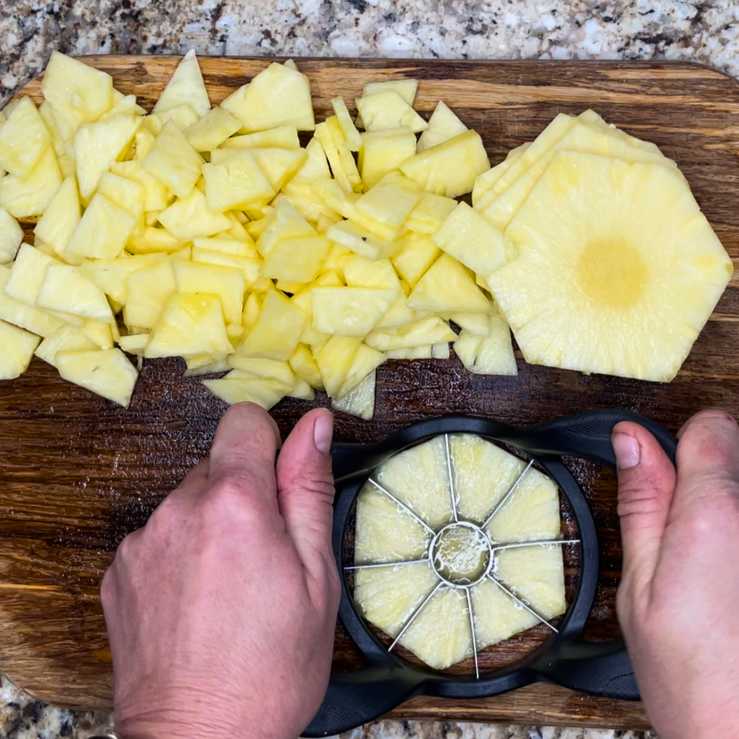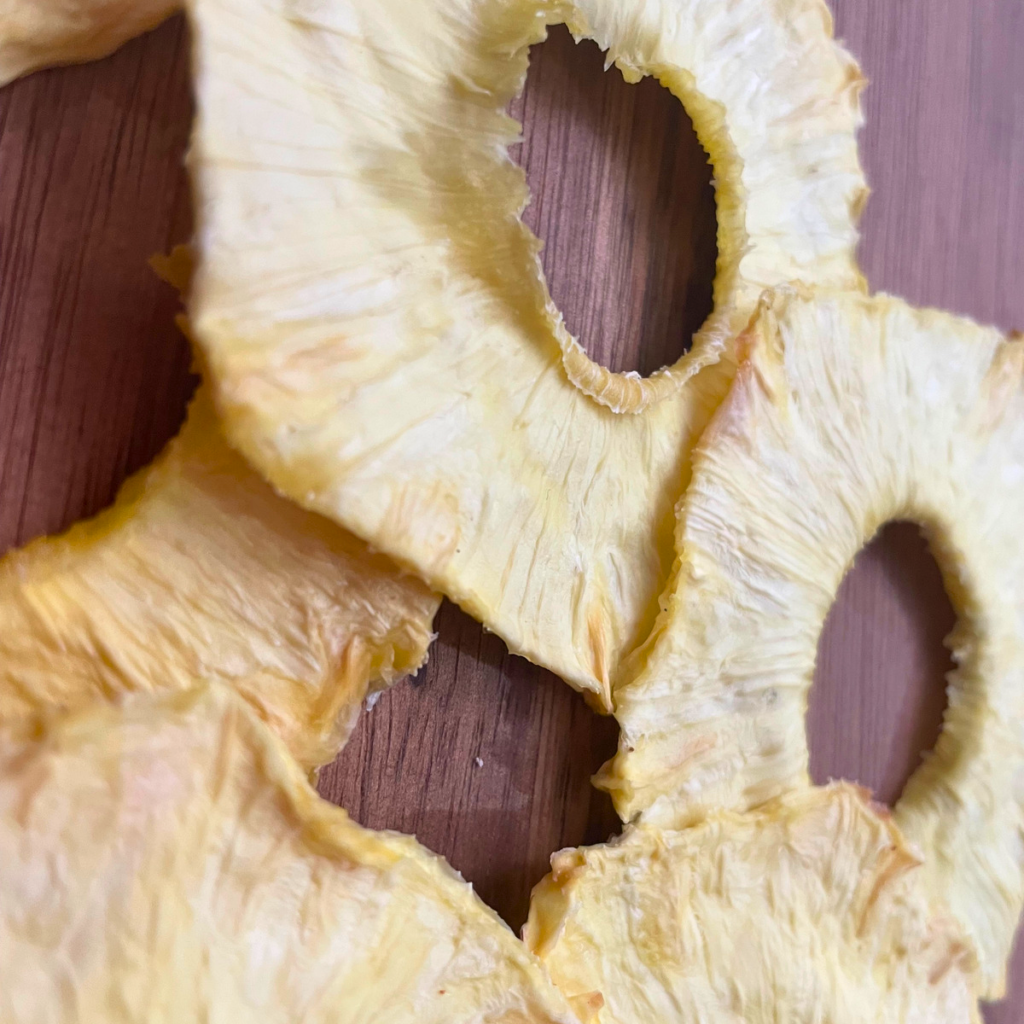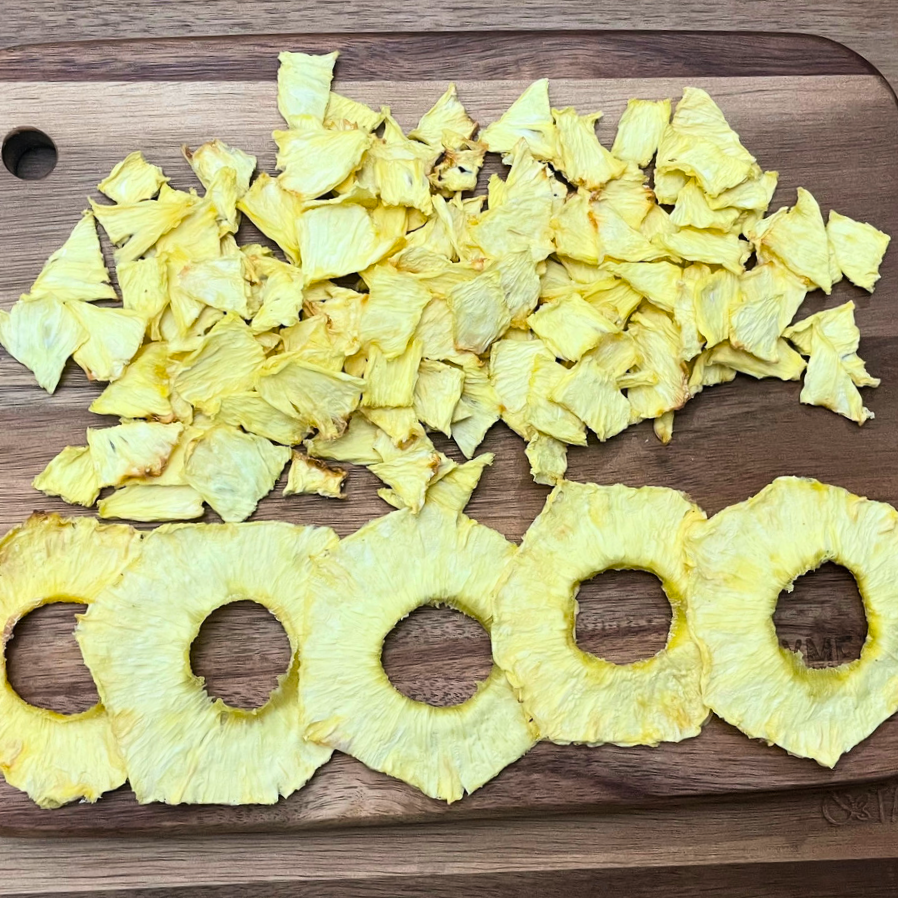Dehydrated pineapple is one of my favorite “healthier” snack choices. It is a sweet and chewy alternative to the chocolaty and sugary treats I am typically making. With spring time upon us I am ramping up to start dehydrating some fresh fruits and veggies. Dehydrating pineapple, because of the heat, does cause it to lose a lot of the nutrients while increasing its sugar content. It does, however provide you with 50% of the Vitamin C needed daily, while its calcium and potassium content is reduced by 50% it is still beneficial.
PICKING THE RIGHT PINEAPPLE
Picking the right Pineapple is your first thing you need to do when making dehydrated pineapples from fresh pineapples. So, how do you decide which one is ready? Make sure it looks fresh and is free of mold or dark spots near the steam. The leaves should be glossy and the rind will have a yellowish-brown color. Now life it to your nose and smell the base of the fruit. When it is ready to be eaten or dehydrated it should have a sweet and fruity scent.
DO YOU HAVE TO USE FRESH PINEAPPLE TO MAKE DEHYDRATED PINEAPPLE? No, actually you can use fresh, frozen, or canned pineapple to make dehydrated pineapple. It just depends on your preferences or what you have available.
WHICH KIND OF PINEAPPLE IS BEST FOR DEHYDRATING: FRESH, FROZEN, OR CANNED?
There are certain times of the year when it’s pretty hard to find fresh pineapple because it’s not in season, so there are times you may need to use canned or frozen. Let’s look at the options.
FRESH PINEAPPLE

The main growing season for Hawaiian pineapples is from April to June, while the Caribbean pineapples have two growing season: August through September and December through February. So, as you can see, there are times of the year when you would be hard pressed to find a fresh Pineapple.
BUY THEM UP WHEN ON SALE
During the peak seasons you can find some great sales on Pineapples. I enjoy using fresh pineapples because, in addition to a great taste, I can choose the shape I want to cut them into. Like I made rings and chunks with this one. The only con I can think of besides availability is that it is a little messier and more time consuming.
CANNED PINEAPPLE
Canned pineapples come in several options: crushed, chunks, slices, etc.. I wouldn’t try to dehydrate crushed pineapple. Using canned pre cut pieces makes dehydrating pineapples quicker and less messy. However, you pay for convenience so it is not as cheap as using fresh pineapples in season.
FROZEN PINEAPPLE
Frozen pineapple is the most expensive option. They are easy to use, the least messy option, and they have great taste and color.
No matter which option you go with, the most important thing with dehydrating is that you have consistent thickness with your pieces.

INGREDIENTS LIST
- Pineapple
VIDEO OF THE PROCESS
LIKE VIDEO’S? FOLLOW ME ON –> YOUTUBE
FOLLOW ME ON SOCIAL MEDIA AND SHARE THIS RECIPE
SIGN UP FOR NOTIFICATIONS SO YOU NEVERMISS AN UPDATE
STEPS TO MAKE DEHYDRATED PINEAPPLE
These steps are for using fresh pineapple but can be modified for using canned or frozen. Really the only difference is the preparing of removing the exterior of the fruit, the core, and cutting them up. Make sure the pieces are of uniform thickness is the main concern and then the placing them on the trays, temperature setting, and time involved are the same.
1. Lay the pineapple on its side. About 1″ from the ends cut off both the top and bottom.

2. Next, stand it up vertically and try to slice just under the outside rind of the pineapple. Removing the hard exterior. You can come back and remove an eyes that are still attached to the pineapple but you don’t want to cut and and throw away anymore fruit then necessary.
3. Now that the fruit is left exposed you can decide if you want to cut it into rings or chunks.
4.If you are cutting it into rings slice the pineapple in thin layers just like when you removed the top and bottom of the pineapple by laying it horizontally.

5. Then use the knife or a round spoon to cut out the core in the center and pop it out of the ring.
6. If you are going to cut it into chunks, stand it on end and slice down from the top on the outside of the central core. Then again cut into equal bite size pieces. You can also use the apple corer and chopper to cut rings into chunks and remove the core at the same time or, of course, use a pineapple peeler/corer.

7. Place the pieces on the trays of the dehydrator leaving space between them all. Use as many trays as needed.

8. Then turn the temperature to 135 degrees, put the lid on and start.

They should be fully dehydrated in 10hours or so based on the thickness of your pieces.

HOW DO YOU STORE DRIED PINEAPPLES? You will want to keep your dehydrated fruit in airtight plastic or glass. I knew my kids would eat mine right away so I just kept it in a Ziplock bag on the counter. This is also what we do when adding it to a trail mix but we vacuum seal them if using them at a later time.
The National Center for Home Food Preservation recommendation is, “When the fruit is taken from the dehydrator, the remaining moisture may not be distributed equally among the pieces because of their size or their location in the dehydrator. Conditioning is the process used to equalize the moisture. To condition the fruit, take the dried fruit that has cooled and pack it loosely in plastic or glass jars. Seal the containers and let them stand for 7 to 10 days. The excess moisture in some pieces will be absorbed by the drier pieces. Shake the jars daily to separate the pieces and check the moisture condensation. If condensation develops in the jar, return the fruit to the dehydrator for more drying. After conditioning, package and store the fruit as described above.”
CAN YOU DEHYDRATE PINEAPPLES IN THE OVEN? Absolutely you can. Use a baking sheet lined with parchment paper and run the oven on the lowest heat setting, which is normally around 170 F, and allow around 10 hours. If it’s still not dry leave it in and recheck it every 30 minutes until it’s fully dehydrated.
Of course oven temperatures vary and it can be affected by humidity levels as well so you can’t put an exact time on it.
WHAT ARE SOME WAYS YOU CAN USE DEHYDRATED PINEAPPLES? Dehydrated pineapple is the a chewy, flavorful snack on it’s own but that’s not the only way you can enjoy it.
One of our favorite ways to enjoy it is mixed into a trail mix with lots of other goodies some salty, some sweet and a handful of M & M’s. You can rehydrate it a bit and add it into some fruit salad, or oatmeal, or pudding. Add it to certain herbal teas as a natural sweetener or into some fun mixed drinks. Let me know how you enjoy yours.
Please share your creations with me if you try this recipe on Facebook and Instagram.
Here are some other recipes you may enjoy *Strawberry Spoon Cake *Coffee Bean Cookies *Mandarin Roll Cake

DEHYDRATED PINEAPPLE
Equipment
- 1 dehydrator
Ingredients
- 1 Pineapple ripe
Instructions
- Lay the pineapple on it's side and cut off the top and the bottom about 1 inch in.
- Then stand it on end and try to slice just under the outside rind of the pineapple.
- Then go back around and remove any eyes still attached.
- Now that the fruit is left exposed you can decide if you want to cut it into rings or chunks.
- If you are cutting it into rings slice the pineapple in thin layers just like when you removed the top and bottom of the pineapple.
- Then use the knife or a round spoon to cut out the core in the center and pop it out of the ring.
- If you are going to cut it into chunks, stand it on end and slice down from the top on the outside of the central core. Then again cut into equal bite size pieces. You can also use the apple corer and chopper to cut rings into chunks and remove the core at the same time or, of course, use a pineapple peeler/corer.
- Place the pieces on the trays of the dehydrator leaving space between them all. Use as many trays as needed.
- Then turn the temperature to 135 degrees, put the lid on and start.
- They should be fully dehydrated in 10 hours give or take based on the thickness of your pieces.
